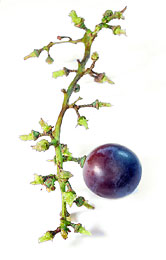 What happens when you add too much tannin? I’ve been making wine for about 5 yrs now and have had good results for each of the many fruit wines that I’ve made…I was always very careful to make sure measurements were accurate…this time making a pear wine, I made the mistake of picking up wine tannin powder and added 2 tbls…I was suppose to be adding pectic (which is what I thought I was holding)….when I realized what I had done, I was able to pull some of the tannin out, since I hadn’t mixed the must…though I’m sure I didn’t take enough of it back out…can this be fixed or do I need to trash this wine…
What happens when you add too much tannin? I’ve been making wine for about 5 yrs now and have had good results for each of the many fruit wines that I’ve made…I was always very careful to make sure measurements were accurate…this time making a pear wine, I made the mistake of picking up wine tannin powder and added 2 tbls…I was suppose to be adding pectic (which is what I thought I was holding)….when I realized what I had done, I was able to pull some of the tannin out, since I hadn’t mixed the must…though I’m sure I didn’t take enough of it back out…can this be fixed or do I need to trash this wine…
Name: Lu
State: NY
—–
Hello Lu,
Wine tannin powder adds a dry, puckering zest to the wine. It is the zest, literally. It comes from the stems and outer skin of the grapes. Think of what it would taste like to chew on a grape stem or some grape skins, and that’s the flavor we are dealing with in this situation.
It is possible that that you added enough wine tannin powder to make your pear wine permanently unpleasant to drink, but there is hope. Much of the wine tannin you added will simply drop out of the wine. Any wine is only able to saturate so much tannin. The excess will never dissolve, or only temporarily dissolve, and drop out as sediment during the fermentation.
One thing you can do to help drop out excess wine tannin is to warm up the wine. As the temperature goes up the wine’s ability to hold tannin goes down. It drops out as more sediment. The problem with doing this is that heat also promotes oxidation. This is where a white wine will turn amber, or in the case of a red wine, it will turn orange or brown. Pear wines are very susceptible to oxidation, so this make this a very delicate situation.
Here’s What I Would Suggest
Once the wine is done fermenting and has cleared the best it can on its own, gently warm the wine up to 85°F. This can be done with a heat source as mild as a 100 watt light bulb. It may take a day or better for the temperature to rise.
Once up to 85°F. add a dose of bentonite to the wine. Bentonite is great for dropping our excess proteins — tannin being one of them. It is the closest thing to a wine tannin remover as you will find. Keep the wine at 85°F until it becomes clear again, usually 2 to 4 days. Then rack the wine off the sediment and allow to cool back down to normal temperatures.
Three things that would be helpful in reducing the affects of oxidation from this process would be:
- Add ascorbic acid to the wine, now. Ascorbic acid will help to limit the oxidative reactions throughout the wine making process and from heat. The dosage should be 1/8 teaspoon per gallon.
- Keep the wine vessels topped-up. Don’t allow air-space to be in with the wine.
- Keep the wine sulfited. You should add a dose right after the fermentation has completed and again, after adding the bentonite. This could be either: Campden tablets, sodium metabisulfite or potassium metabisulfite.
Some additional thoughts: Wines with too much wine tannin powder tend to need more aging, but once aged out they tend to taste better than the same wine low in tannin. This is all subjective, of course, but it is a general consensus among winemakers. So you have that going for you. Also, wine tannin lowers the pH of a wine. Low pH is deterrent to oxidation, so this is a good thing for your pear wine, as well.
It sums up to this: the fact that you added too much wine tannin powder does not necessarily mean your wine is ruined. There are ways of reducing it. Both heat and bentonite act in concert as a wine tannin remover to some degree. Time can also help to reduce any astringent effects the wine tannin powder that may still be left in the wine, so there are a lot of reasons not to give up on your pear wine.
Best Wishes,
Ed Kraus
———————————————————————————————————
Ed Kraus is a 3rd generation home brewer/winemaker and has been an owner of E. C. Kraus since 1999. He has been helping individuals make better wine and beer for over 25 years.

Your comment regarding too much tannin should have also included adding sorbate/sulphite and adding some sweet reserve or sugar water to help mask the dryness of the tannin . You would not need a lot, maybe 40 to 70 mls. per batch.
You can use egg whites to reduce tannin in wines, its one of the best clarifying and or tannin reducing elements. Just take the whites of an egg, mix with filtered,bottled or distilled water, and put a pinch of salt. mix enough to blend it lightly but dont over do it, and pour the mixture into the wine. This will significantly reduce tannin and or particulate matter in wine. Bentonite is also good, same with Chitosan or Kiselsol as long as you arent allergic to shellfish.